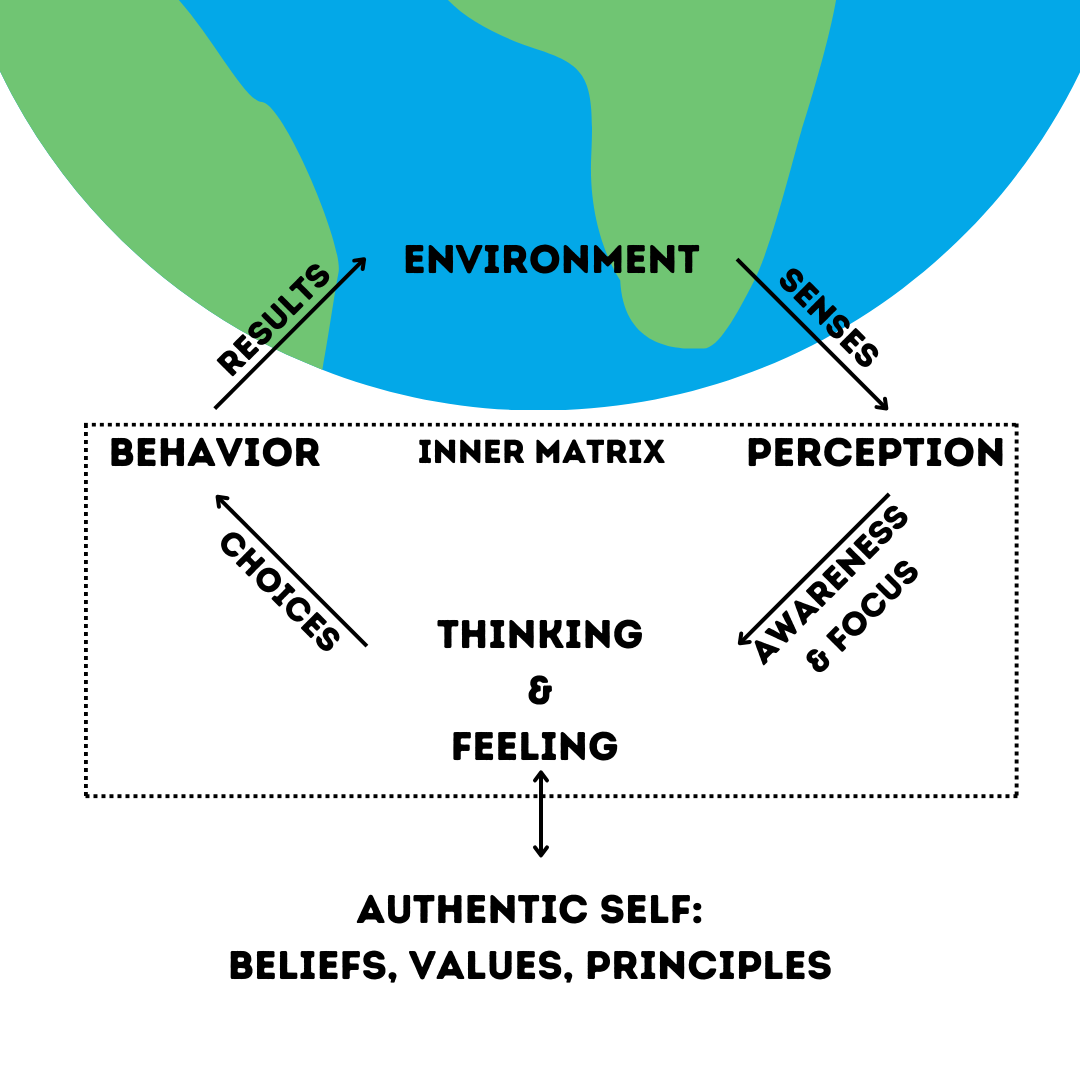The Power of Feeling
The Third of Four that Shape Reality
Welcome to Part 4 of the “Wheel of Fate Series,” where we delve into the art of living by creating the life experience you desire, aligned with your authentic self.
The “Wheel of Fate” framework provides a practical explanation for what many refer to as Manifestation. In the series' final article, I'll discuss how to Cultivate your preferred life experience, going further than traditional manifestation techniques, to tie the series together.
If you haven’t already, I encourage you to read through the previous parts in the series:
Part 1: I Sought Control, and then Found Peace.
Part 2: The Power of Perception: The First of Four that Shape Reality.
Part 3: The Power of Thinking: The Second of Four that Shape Reality
This six-part series is interconnected, with links at the end of each article as they become available. Subscribe to receive updates.
In Part 1, we explored how our external world is shaped by our inner world—the Inner Matrix.
In Part 2, we saw how altering our perception can change our reality and how to shape how we experience it. In Part 3, we learned how to use our minds to provide structure and clarity to the Inner Matrix for its proper functioning.
In today's Part 4 read we're swimming in feelings!
The big takeaway: While Thinking shoots the gun, Feeling aims it.
Part 3 shows us how perfect your mind is for shooting that gun, but if our heart isn't in it, we're shooting aimlessly. That means the Inner Matrix isn't going to function as well as it could. In terms of cultivating your preferred life experience, this is a problem.
Feelings have a seat at the table, just like Thinking and Perception. They give direction, purpose, and meaning to our decisions and behaviors.
Many people push feelings away leading to decisions that lack depth, compassion, and deeper wisdom behind them.
Why do you think that is?
No matter how hard we try, feelings will always have that seat at the table. We best learn how to use them. If we do, our decisions and behaviors will line-up with the deeper inspirations of your soul.
In today's read you're going to learn:
An analytical approach to understanding feelings.
How to emotionally regulate for better perceptive ability and decision-making.
Why discipline and motivation are on the same team and which one is represented by our emotions.
How feelings ultimately guide you to your authentic self and are the catalyst for legacy and creation in the human experience.
People will forget what you said,
people will forget what you did,
but people will never forget
how you made them feel.—Maya Angelou
The Nature of Feelings
Feelings can be complicated so let's simplify!
There are a bazillion different words to describe the nuances that reflect our feelings. Sometimes the way we feel is beyond words. This makes the language of feeling more powerful than the language of intellect.
We already know this at some level: “A picture is worth a thousand words.” Why? because pictures evoke feeling and meaning that would take more than a thousand words to describe.
The best of the best in the marketing industry don't tell you how great their product or service is, they make you feel how great it would be if you had it—or how bad it would make you feel if you didn't.
And here we have stumbled upon the first clarifying question in understanding our feelings:
Is this a good feeling or a bad feeling?
Let's think a bit about what makes a feeling “good” or “bad.”
Simply put: a good feeling comes when something bad goes away, or something good comes our way. Conversely, a bad feeling comes when something good goes away, or something bad comes our way.
A lightening storm at a game match feels bad
Finding $5 in your pocket feels good
Losing body fat (generally) feels good
Losing your retirement to a Ponzi scheme feels bad. Very bad.
The Ponzi scheme example brings up the idea that some feelings can feel much more intense than others.
The intensity of a feeling is a subjective measure of its perceived importance:
Finding $5 feels good, but losing body fat probably feels better. It feels better because it's harder to lose body fat than get $5. Losing body fat has higher perceived value, which boosts perceived importance and the intensity of the feeling.
A lightening storm at a game match feels bad, but losing your retirement feels worse.
Feelings allow us to subjectively quantify significance between otherwise un-relatable entities.
All things being equal, we perceive bad feelings to be more important than good ones. While this is great for threat and risk-avoidance, it's bad for getting out of our comfort zone which is where growth, opportunity, and the life we want often waits.
Learning how to “aim the gun” begins with asking yourself two questions:
Is this a good feeling or a bad feeling?
Is the intensity behind this feeling appropriate, over-inflated, or discounted?
These two questions can put your feet on the right path to exploring:
what exactly is good or bad about the feeling
why the feeling is good or bad.
if your perceptions are balanced and on point and if not, what is contributing to that shift off-balance?
These questions serve as a great example, by the way, of how Mind helps to structure both what we feel and what we perceive.
How do we use self-reflective inquiry like this to arrive at appropriate emotional responses?
Emotional Regulation and Perceived Importance
Emotional regulation, or feeling emotions without being overwhelmed by them, enlightens and clarifies our Inner Matrix.
It is enlightening, literally, in the sense that it can shift the inner climate to a more “sunny” disposition, and an inner atmosphere of “less weightiness.” And also, enlightening because it fosters ways of perceiving and thinking that are not possible when emotional dysregulation occurs.
Becoming emotionally unregulated in a difficult situation can limit and distort your thinking and perception. Remember, feelings aim the gun.
This implies that if we can actively emotionally regulate, we can bend the course of our life experience by making more accurate and opportunity-rich decisions. This ability emerges as a function of enlightened thinking and more accurate perception.
Emotional regulation is a mindfulness practice. It is a decision made by the mind, before it goes into simulation mode and allows our inner matrix to get spun up into anxious or depressive spirals (for a refresher, return to Part 3: The Power of Thinking section “The Double-Edged Sword of Future and Past”).
In Part 2: The Power of Perception, we learned that our Inner Matrix works through patterns—triggers lead to thoughts, which lead to behaviors, often without our awareness. Without mindfulness, that is, the mind's effort to notice and adjust these patterns, we can become emotionally unregulated. Without mindfulness we engage in less than ideal perception, thinking and feeling, and ultimately action.
For this reason, in Part 3, I mentioned that anxiety and depression should prompt us to examine our Inner Matrix more closely. These feelings often indicate we're not regulating emotions well and signal the need to practice mindfulness.
Anxiety is often a signal of emotional overestimation (hyper-reactivity) while depression is often a signal of emotional underestimation (numbing). Both states incorrectly calibrate intensity appropriately to situations.
Once in a mindfulness state, we can actively work through our emotion without becoming emotional:
Is my intensity appropriate for the situation at hand?
Can I extend the time-horizon so that I don't feel as much urgency?
Can I think of similar situations that worked out fine?
Can I think of skills I already have that might prove helpful?
But at times, there is an even more powerful way of engaging in mindfulness.
Am I looking at this the wrong way? Might this be a good thing after all?
Can I think of ways this might turn out in my favor?
Can I think of lessons I might come away with that will improve survivability and thrive-ability?
Can I think of opportunities this might lead to?
This one might be up there with Master Yoda (for you Star Wars fans, like me).
These two strategies speak to the two questions from the previous section:
Is this a good feeling or a bad feeling?
Is the intensity behind this feeling appropriate, over-inflated, or discounted?
What I mean is that a powerful way to emotionally regulate is to redefine our perspective on what is “good” or “bad.” This shift in perspective changes our biases. A bad feeling can transmute into a good one, and thus shift away from emotional dysregulation.
The other way of emotionally regulating is to make sure our intensity is calibrated correctly to the situation and explore ways to dial down the intensity by changing assumptions or the rules of the game.
At this point you have an understanding of what it takes to emotionally regulate and why it's important. But there are more angles to the experience of feeling that you should know to fully engage this component within your inner matrix.
Let's begin by contemplating which component is more important? Mind or Heart?
The answer to your growing understanding of the Inner Matrix may surprise you.
Revisiting the Self-Reflexive nature of Thinking and Feeling with Perception
Thinking and Feeling are sibling components related to how we process the inner and outer worlds.
It's easy to side with one or the other: “Follow your heart,” “Do what feels right,” “Use your head!” “Discipline over motivation.” But, really these are two sides of the same coin.
Now armed with an understanding of just how important feeling is at calibrating our perception, thinking and behavior, Feeling is not the odd-ball out: “who invited Feeling here?”
Not at all.
In fact, Thinking and Feeling best work in concert. They both process inputs from two different but complementary perspectives. The mind in a linear, analytical, and focused way, the heart in an abstract, intuitive, and holistic way. They work together to help inform Perception filter life experiences with greater nuance.
When Thinking and Feeling along with Perception work in harmony, they continuously influence and improve the other components of the Inner Matrix.
We've discussed how perception and thinking contribute to Inner Matrix harmony. This involves noticing what Perception filters allow in, or out, and ensuring Mind first adds structure and clarity through decision-making before forecasting scenarios (again, return to Part 3: The Power of Thinking section “The Double-Edged Sword of Future and Past” for supporting explanation).
Now, we've filled in the final piece of the reflexive puzzle between Perception, Thinking, and Feeling. Learning how to regulate the polarity of an emotion along with its intensity has reflexive effects on Thinking and Perception. All while Perception and Thinking have reflexive effects on Feeling.
But what are some of the pitfalls associated with unregulated emotional responses? How might they affect our Inner Matrix and life experience in ways we have not yet addressed?
The Pitfalls of Unregulated Emotional Responses
Bad feelings can be so uncomfortable that we become motivated to find relief from them.
The knee-jerk reaction is to find a quick and easy way out. This often occurs at the expense of long-term well-being. Our perception is that it is acceptable to tradeoff long-term thrive-ability in exchange for increased survivability in the short-term.
For example, if we become emotionally dysregulated—we feel bad—we might turn to alcohol or food to modify the climate of our Inner Matrix. But this comes at the expense of long-term health and leads to addictions.
Anything that modifies the working of our Inner Matrix toward short-term comfort without addressing the root cause of the uncomfortable feeling becomes addictive.
Addictions are by their very nature a loss of free-will and hinder the complementary functions of the Inner Matrix components. In the same way that anxiety and depression can signal a need for mindfulness, so too does addictive behavior, or conflicting desires between short-term and long-term tradeoffs.
Many of us fall into addictive behaviors, or at least less than ideal behaviors as it relates to our long-term ideals, and feel we lack the discipline and/or motivation to change.
How can Feeling help us aim toward our long-term ideals, rather than short-term comforts?
Feelings as Motivators
Feelings give depth to our decisions by motivating them.
When we're stuck with conflicting desires, it is our job to motivate the desire that will enhance thrive-ability as long as short-term survivability is not at stake.
In the previous section we see how this job is hijacked by less than ideal behaviors. Within such habits, we motivate the short-term desire to cope with the bad feeling, but our survivability is not at stake. At the same time because we're motivating the short-term desire, we are not motivating the conflicting long-term desire that often speaks to our thrive-ability.
We fail at our job to enhance thrive-ability as long as short-term survivability is not at stake. Motivating the short-term desire which has nothing to do with our survivability in the moment, unmotivated the long-term desire that would enhance thrive-ability.
💡 Because we feel better in the short-term there is a sense that we have improved survivability at the level of our primal brain. But choosing comfort in the short-term is rarely necessary for survivability, and often limits thrive-ability.
The solution again is mindfulness and recognizing that you are motivating the wrong decision and that's why you don't have motivation for the right one!
So which is more important? Discipline or motivation?
Most will say discipline. And from one perspective they're not wrong. Sound discipline brings consistency. Consistent behavior brings results.
But what this misses is the power of motivation. With motivation, disciplined consistent behavior becomes purpose-driven. There almost isn't a choice but to continue being disciplined when the right desire has motivation behind it.
For a deep-dive, well-received article on this shift in perspective, check out:
Igniting motivation happens through mindfulness by remaining true to the one, most-impactful discipline practice: The discipline of motivating the right desire. By doing this, short-term desires won't distract you from your long-term goals for mere temporary comfort. True, lasting comfort is achieved by those who master this balance.
But often on matters of the heart, the mind knows no reason, as Blaise Pascal, 17th-century physicist and philosophy opined, "The heart has its reasons of which reason knows nothing.”
Feelings can be quite conflicted sometimes. And we know the mind's job is to offer clarity. If it is true that “the heart has it's reasons of which reason knows nothing,” how are we to call upon the functions of Mind to choose the right and true desires of the heart?
Feelings and Authentic Self
“Know thyself,” is Socrates' most profound and meaningful two-worded lesson.
He taught that self-knowledge was the foundation for wisdom. And if I could stand up from my humble seat and join him in Raphael's School of Athens, I'd have to agree.
I'd agree, because in knowing yourself you tune into those desires that come from the deepest parts of your being. And if you can choose to motivate those desires, your Inner Matrix will line up with those deep principles that are core to who you are.
You will develop the personality that Perceives, Thinks, Feels, and Behaves as your embodied soul in the world would want you to—indeed how, with that inner wisdom—you would train yourself to become.
The Inner Matrix serves as a sort of metaphysical adaptor between our spiritual self and our physical reality. Through the creation and ongoing development of a personality and learning how to use it effectively with frameworks like the Inner Matrix theory, we learn to become an effective channel for our soul in this world through mind and body.
This begs the question then, How do we discover who we truly are?
If we can do this, then we can line up with the right desires by motivating them and creating the life experience we want. We practice through understanding and integrating what we learn about our Inner Matrix
Could Feeling play a significant role in this discovery?
Indeed it does.
As you take on the unknowns of life, practice using your Inner Matrix, and live out your life experience, your heart is there to guide you.
Your feelings aim the gun.
With mindfulness, harmonizing the Inner Matrix increases your ability to direct its functioning and thereby aligning it with your authentic self.
Your way of sensing if your Inner Matrix is moving down the path toward or away from your authentic self comes down to nothing more than the first question we asked at the beginning of this article:
Is this a good feeling or a bad feeling?
Yes, it is that simple.
You have to transcend the limitations of Mind intellect if we are to achieve the deep level of self-knowledge necessary*.* I want to refer back to a point I made at the beginning of the article: that the language of feeling more powerful than the language of intellect. **Here we can see why.
The form of self-knowledge needed to “know thyself” only comes through experiences, through failures, through mistakes, through feeling bad and working through it rather than coping and distracting yourself away from it.
Its completion depends on more than mere mental exercise. It depends on experience and the feeling-knowledge that comes with it. It reflects the truth behind the dichotomy of “book-knowledge” vs “experience.” Both, together, lead to mastery. In this sense, self-mastery comes from learning to use Mind and Feeling in an integrative way.
Self-knowledge comes from motivating the true desires that speak to your inner authentic ideals. It comes from finding harmony within the Inner Matrix as experiences push and test your ability to remain emotionally regulated.
It is not a linear path.
If your heart is a compass aiming you in the direction to shoot, it is often the case that the reality you find yourself in requires you to make decisions—to take a shot—that will not line up directly with your ideals. Nevertheless, even when you cannot walk the path toward your authentic self, you are making progress by moving through experiences that reveal what it is not.
So whether by lack of self-knowledge, or the limitations of reality, your Inner Matrix may not always allow you to aim and shoot accurately at authentic desires.
You might misunderstand who you are, you might make mistakes. It doesn't matter. It all reveals the true nature of who you are if you will only be mindful of your Inner Matrix as you move through life's experiences.
Good feelings—and by that I mean those deeply satisfying ones— will generally take you in the direction of your authentic self.
Trust it with self-compassion as you encounter the potholes and stones along the way.
Feelings as the Catalyst for Creation
You might feel we've explored a core part of the human experience that allows us to bring fresh insights into our basic understanding of the Inner Matrix.
You would be correct.
As we have progressed in this series, moving from the external world through Perception, Thinking, and Feeling, now to our core identity, a powerful and incredible truth emerges:
Through understanding the Inner Matrix and its components you learn to structure and regulate it through Mind and Heart. You learn how to accurately perceive your outer and inner worlds. And these abilities afford you the opportunity to aim the lens of your attention at the core pillars of your very being-ness.
We learned in Part 2 that perception is our filter on the outer and inner world; in Part 3, that thinking provides structure and clarity through decision-making.
This unlocks within your life experience the ability to effectively create something in the world that only YOU can create.
No one has, is, or ever will be you again.
I believe it it our deepest purpose to discover who we are, and draw up from the depths of our being the catalysts necessary to create something new in our outer world. Creating that legacy for all humanity in the way that only you are uniquely capable of doing provides meaning, direction, and truly motivates the authentic desires within.
No matter how small the legacy you have already created is, it has already established its ripple effects for our collective future as a species, our world, and whatever our world will contribute to the universe:
Being a parent
Guiding a friend
Helping to make someone else's life easier through the master of a skill you have learned
Planting a garden
Reading a book
Writing a book
Painting an vision
All of it builds your legacy. Make that legacy reflect who you truly are.
In Part 4, we learn that feelings guide the purpose and direction of our decisions. Philosophically, aligning these decisions with your true self is key to a fulfilling life, happiness, and leaving a legacy.
How can someone do this without Feeling?
Feelings aim the gun.
To forge a new creation and leave a lasting legacy, we must grasp and align the three components—Perception, Thinking, and Feeling—with the fourth and final component of the Inner Matrix: Behavior.
For that, I'll see you in Part 5: The Power of Behavior: The Final of Four that Shape Reality.
Future Articles in the Series
Look out for these future articles in the series. Be sure to subscribe so you are notified when their posted!
Behavior: How changing our actions can transform our environment and ourselves.
The Wheel of Fate: Embracing destiny through Authenticity.
Return to Previous Article in the Series
Environment: Shifting from Controlling the Environment to Mastering the Inner Matrix.
Perception: How altering our perception can change our reality.
Thinking: The power of thoughts in shaping our emotions and behaviors.











